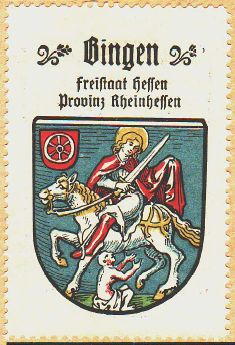Bingen am Rhein: Difference between revisions
Knorrepoes (talk | contribs) m (Text replace - "[[Literature" to "{{media}} [[Literature") |
Knorrepoes (talk | contribs) m (Text replace - "The arms in the Kaffee Hag albums +/- 1925 " to "The arms by Hupp in the Kaffee Hag albums +/- 1925 ") |
||
| Line 26: | Line 26: | ||
{|align="center" | {|align="center" | ||
|align="center"|[[File:bingenz1.jpg|center]] <br/>Seal from around 1900 | |align="center"|[[File:bingenz1.jpg|center]] <br/>Seal from around 1900 | ||
|align="center"|[[File:bingen.hagd.jpg|center]] <br/>The arms in the [[Kaffee Hag albums]] +/- 1925 | |align="center"|[[File:bingen.hagd.jpg|center]] <br/>The arms by [[Otto Hupp|Hupp]] in the [[Kaffee Hag albums]] +/- 1925 | ||
|} | |} | ||
Revision as of 07:21, 21 November 2014
| Heraldry of the World Civic heraldry of Germany - Deutsche Wappen (Gemeindewappen/Kreiswappen) |
BINGEN AM RHEIN
State : Rheinland-Pfalz
District (Kreis) : Mainz-Bingen (until 1969 Bingen)
Additions : 1929 Büdesheim; 1939 Gaulsheim, Kempten; 1969 Bingerbrück; 1972 Dietersheim, Dromersheim, Sponsheim
Official blazon
Origin/meaning
The arms show St. Martin, the patron saint of the town and the arms of the State of Mainz.
Bingen became a city in the early 13th century and the oldest seal of the city, shows St. Martin sitting on a throne like a bishop. This is an identical seal as several other cities in the State of Mainz (see Miltenberg and Aschaffenburg).
Later seals show St. Martin in the more common way, as a knight cutting his coat for a beggar. Not always was St. Martin shown on the arms, sometimes only the wheel of Mainz was used.
| Seal from around 1900 |
The arms by Hupp in the Kaffee Hag albums +/- 1925 |
Contact and Support
Partners:
Your logo here ?
Contact us
© since 1995, Heraldry of the World, Ralf Hartemink 
Index of the site
Literature : Stadler, K. : Deutsche Wappen - Bundesrepublik Deutschland. Angelsachsen Verlag, 1964-1971, 8 volumes.













